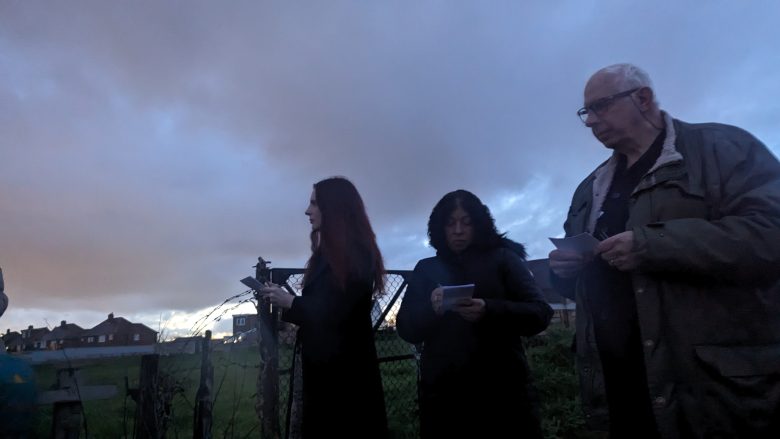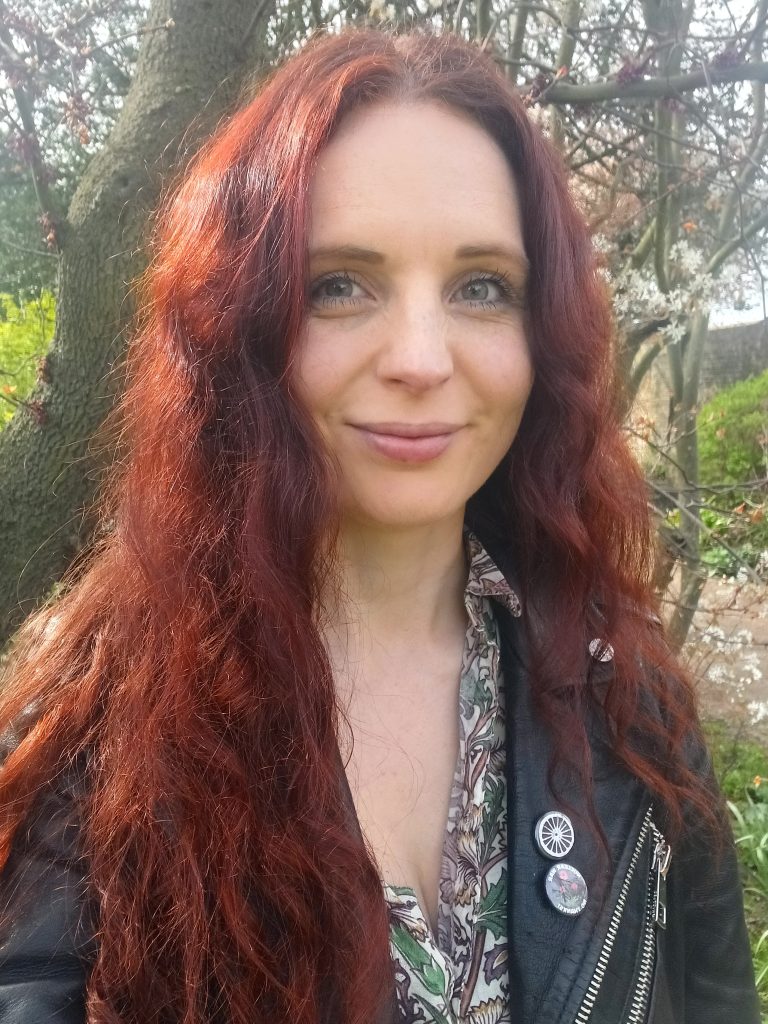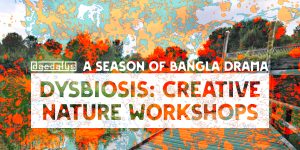Above photo: Ruth, far left, looking out at the view from Wennington Church.
We invited Havering local, environmental activist and writer Ruth Kettle-Frisby to write a guest blog article on DYSBIOSIS after attending some of our DYSBIOSIS Creative Nature Workshops in Havering this month.
What is nature to me?
When I first saw the term Dysbiosis – the title of the creative workshops here in Havering by Daedalus Theatre Company – my mind began to juxtapose discordant thoughts that seemed nevertheless to harmonise. Funnily enough, it is this very paradox that encapsulates nature.
Nature functions to such a finely tuned degree that the earth spins on its axis around the precise gravitational force to sustain life; and this mechanical harmony extends to our localised experiences here on earth, which can be beautiful to behold.
There are few things I enjoy more than an enchanted stroll around Warley Place when it’s sprinkled with clumps of dewy snowdrops glistening in the morning sun, sporadically dissected by ancient trees, some even thriving in supine slumber after great storms…or treating fluffy ducklings, flapping feral pigeons, and tame grey squirrels to veritable feasts at Langtons Gardens on a crisp Spring afternoon: scenes of comical unrest annually reverberate from the resident cob, angrily chasing persistent Canada geese from the lake; loss and sadness rippling in the still air as it becomes apparent on returning children’s fingers, that numbers no longer add up, and he’s attacked some of his own cygnets.
Nature continues to inspire artists, photographers and musicians; it provides us with sustenance, shelter, oxygen and medicine; it grinds our remains deep into its geology, and it contains coded messages of hope, regeneration and resilience, much like the Gingko trees that survived after the atomic bombings of Hiroshima and Nagasaki. Nature also has the ability to overwhelm with its might, brutality and caprice; blithely indifferent to some of our deepest instincts and desires.
In spite of our symbiosis with the rest of nature – to which we are intimately genetically connected – the dysbiosis we continue to wreak on our planetary ecosystems, with our continued burning of fossil fuels and so on, is destroying the delicate conditions that sustain a rich variety of life on Earth.
Othering Nature and exploiting others
We often speak of ‘looking at’ nature, objectifying and othering it through a human lens; it’s as though life forms and processes in our ecology existed independently of each other. Although we live off and return to the earth – and breathe the air around us – we have distanced ourselves from assumptive ideas of ‘primitivism’ by disguising our natural interconnectivity in neatly folded plastic wrappers.
The othering and politicising of nature in our language and our concepts can be found in the work of theologists and other thinkers, including social contract philosophers, who instilled fear of the ‘state of nature’ as something brutish that stands in conflict with civilised state control; contrasting nature with Western human rationality, as if human nature could achieve the paradoxical desire to transcend the rest of nature in order to conquer it.
Our post-industrialist dependence on colonialist fossil fuel extraction and persistent burning has led big oil companies to maintain a culture of routinely poisoning the air we breathe, and to heat our shared habitat, which causes climate breakdown that is currently most severe in the Global South. This is making migration an increasing necessity for the survival of a variety of organisms, while pathological dysbiosis penetrates at biological levels with essential enzymes becoming denatured by climate change.
The Covid 19 pandemic tore across the globe; conflicts broke out in Kashmir, East Africa, and the Middle East, as well as the contrastingly highly publicised war in Ukraine; and billions of people have been impacted by floods, droughts and wildfires, always targeting the most marginalised people on the front lines first.
We are already struggling to cope with climate breakdown here in the UK. Parts of our local village of Wennngton were completely destroyed; homes and belongings were lost, and beloved pets and wildlife sadly killed. The UK wildfires of the summer of 2022 carried with them truths reverberating from Western colonialism with dysbiotic warnings, however invariably after such tragedies, those in power find ways to move the conversation along. This perpetuates cultural trends: after jolting reminders of our fragile mortalities, instead of becoming galvanised into action, we endeavour to reinter our dampened awareness that nature will transform and humble our own experiences. Keep calm and carry on, like zombies of convenience; living, polluting and voting, while women and girls of colour and disabled people suffer and die at the sharp end of climate breakdown.
Kant thought that order in nature is the natural effect of our perceptual interaction with it. We are part of nature, and in perceiving it, we succeed in shaping it as it shapes our perceptions of it, creating a natural two-way symbiosis between our perceptual experience and reality. This is an interesting way of un-othering nature, and reconnecting with it conceptually at a metaphysical level, but the cultural story is very different.
The incoherence of selective narratives of dysbiosis
Stripping this down to logic, if nature is all that there is, then can it be ordered or disordered? Surely in the absence of any natural standard of orderliness beyond the socially constructed characteristics, disorder can only represent our perception in terms of reductive binaries that simply reveal truths about us and what we value. We separate flowers from weeds – or pets from pests and livestock – as wheat from chaff … nondisabled human worth from disabled lack of worth. This dehumanisation of people is a dangerous consequence of prejudiced perceptions of dysbiosis; fuelled by sustained, historically embedded power structures, they dominate the narrative to such a degree that they are sewn into the fabric of our basic, often unconscious assumptions.
My eldest daughter is six years old and has CDKL5: a neurodevelopmental genetic condition that is often referred to as ‘CDD’, standing for ‘CDKL5 Deficiency Disorder’. Non-disabled people taking for granted the working protein that was truncated for children like her does not justify the association of ‘deficiency’ and ‘disorder’ with human beings. When something is broken, we tend to fix it or throw it away; when children are labelled as ‘disordered’ by medical communities, nondisabled people with power tend to try either to fix disabled people according to nondisabled standards, or they marginalise them, compromising their worth and their safety in society.
We have spent centuries segregating people. Great thinkers, whose ideas endure today, pronounced some natural functions as ‘natural’, equating arbitrary ‘order’ with goodness; while perceptions of natural dysbiosis were labelled ‘unnatural’ and denigrated to ‘disorder’, abnormality, and sin.
Here we find ourselves in dehumanising territories of supremacist political, religious and social ideologies throughout history. The Nazis persecuted and systematically murdered hundreds of thousands disabled people along with millions of Jews; white supremacist scientific practices fuelled by racist confirmation bias – with no biological basis – were used to justify, propagate and embed pernicious claims of ‘racial inferiority’, and the ‘biological disharmony’ of children of mixed background. Queer people throughout history are dismissed as dysbiotic ‘abominations’ of nature, and continue to live in fear and to suffer humiliation, harm and discrimination.
Intersecting racist, ableist and queerphobic prejudice is designed into all aspects of society, and a culture of worthlessness persists in public conscious and unconscious bias, evidenced throughout history: from celebrated figures such as Virginia Woolf, who described disabled people as ‘imbeciles’; to the ableist comments made by politicians today that betray the lack of humanity, dignity and value that they often feel entitled to attribute to disabled children.
Untangling cultural dysbiosis
The artists at Daedalus Theatre Company have inspired me to question ingrained tropes of dysbiosis that exist in scientific, religious, political and other cultural contexts, that have led us to ultimately minimise, disguise, or even deny the rights and expressions of marginalised people.
How do we emerge from pernicious, supremacist cultural narratives of dysbiosis that have created marginalisation, engendered fear and bracketed off all forms of divergence? They have made their way into violence against women, girls and nature, upholding Western ideas and white coat medicine, widening the gulf between humans and other aspects of nature.
Nietzsche’s philosophy of aesthetics likens traditional human understandings of natural harmony with Apollo – god of reason, order and beauty; and chaotic disorder to Dionysus – god of ecstasy and insanity. Inspiringly, he thought that while we need both principles, we should use our wills to surrender our sense of self to nature in an intoxicated embrace of dysbiotic creativity!
I suspect it to be neither possible nor desirable to consistently bear (let alone affirm) nature in all its dispassionate, destructive revelry. However, I think we have a duty of care to ourselves, each other and our environment to openly question cultural mirages of socially constructed harmony based on harmful misappropriations of ‘nature’, and to find the courage to celebrate radically inclusive expressions of interdependent identity.
Can our propensity to care overcome our impulse to dominate?
Can our propensity to care overcome our impulse to dominate? I don’t know, but I am pinning my hopes on our willingness to unlearn dysbiotic practices of entitlement. I hope we can continue to build momentum for climate justice, and learn to renature ourselves in our surroundings in more sophisticated, forest-inspired, collaborations so that future generations – and as many species as we can hold on to – can dance, play and work together to nature’s rhythms.
In the art world, there are interconnecting shoots popping up that teach us to embrace dysbiosis in all its divergent variety, offering us active opportunities to cultivate creative abandon, and loving acceptance from the grassroots.




Comments
Pingback: Daedalus Signs up to the Theatre Green Book – Daedalus Theatre Company